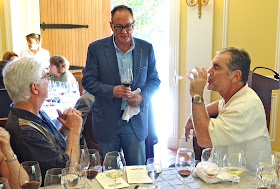 |
| Where do these wines come from? |
Here's the screen shot of the 9 wines. Who makes these sale wines? How are they so cheap?
Thanks to website of the federal government agency responsible for alcohol, the TTB, I was able to look up the Certificate of Label Approval for each wine. I answered some questions, but raised a few others.
Before I get into the details, here's a quick summary:
Wines with brand names that sound like wineries: 8
Wines where the producer is upfront about who's making it: 2
Wines whose brand name IS actually the winery that made it: 1
Here are the wines, from left to right:
Red Autumn Chardonnay
This was in the Wine of the Month Club, which helpfully rated it 94 points.
A group of very enthusiastic wine tasters bought it for $2.99 and declared it "Goooood." It's made by Fior di Sole winery in Napa, which advertises itself as "Premium bulk wine from Napa Valley and other appellations." Remember that name.
Michel-Schlumberger Chardonnay
This used to be a real winery named after the owner, but in 2011 the winery was sold to the Adams Wine Group, an investment group. The winery does list respected consulting winemaker Kerry Damskey, but he is best known as a Mr. Fixit.
So far as I can tell from a COLA search, the wines are no longer being made at the onetime winery building in Sonoma County; they're now being made at RB Wine Associates in Hopland, which has one of the emptiest websites you'll ever see.






































